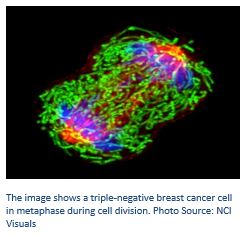 Breast cancer is the second most common cancer in women living in the United States, with triple-negative breast cancer (TNBC) accounting for approximately 15% of diagnoses. While chemotherapy is the standard-of-care in TNBC, resistance is common and associated with poor prognosis. Single agent PI3K (phosphoinositide 3-kinase) inhibitors have shown limited efficacy as a targeted therapy for TNBC, despite observed abnormal PI3K signaling in patients. CPTAC investigator Dr. Steven Carr and his research team at the Broad Institute analyzed a panel of patient-derived xenograft (PDX) models of TNBC with varying responsiveness to the pan-PI3K inhibitor buparlisib. The goal of the study was to identify cellular signaling events associated with sensitivity and resistance to buparlisib treatment.
Breast cancer is the second most common cancer in women living in the United States, with triple-negative breast cancer (TNBC) accounting for approximately 15% of diagnoses. While chemotherapy is the standard-of-care in TNBC, resistance is common and associated with poor prognosis. Single agent PI3K (phosphoinositide 3-kinase) inhibitors have shown limited efficacy as a targeted therapy for TNBC, despite observed abnormal PI3K signaling in patients. CPTAC investigator Dr. Steven Carr and his research team at the Broad Institute analyzed a panel of patient-derived xenograft (PDX) models of TNBC with varying responsiveness to the pan-PI3K inhibitor buparlisib. The goal of the study was to identify cellular signaling events associated with sensitivity and resistance to buparlisib treatment.
As reported in the journal Cancer Research, the investigators integrated deep, whole proteome data, generated by liquid chromatography-high resolution tandem mass spectrometry (LC-MS/MS), with information from kinase and transcriptome profiling. The investigators identified phosphoproteomic changes in PI3K, PLK1 (polo like kinase 1) and MAPK/MEK (mitogen-activated protein kinase) family members in a subset of PDX models. The kinome analyses identified novel candidates NEK9 (NIMA related kinase 9) and MAP2K4 (mitogen-activated protein kinase kinase) as functionally important to buparlisib resistance. These results indicate that NEK9 and MAP2K4 may be important regulators in TNBC, highlighting the importance of using omics approaches like MS-based phosphoproteomics to address translational research questions, advance strategies for patient selection and precision treatment options. The original MS instrument data files for this study are publicly available on the CPTAC Data Portal.

